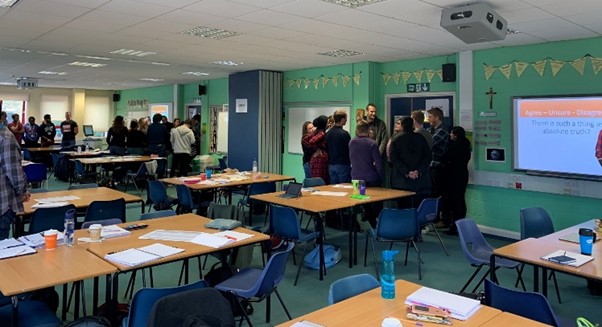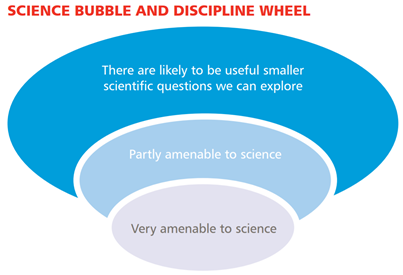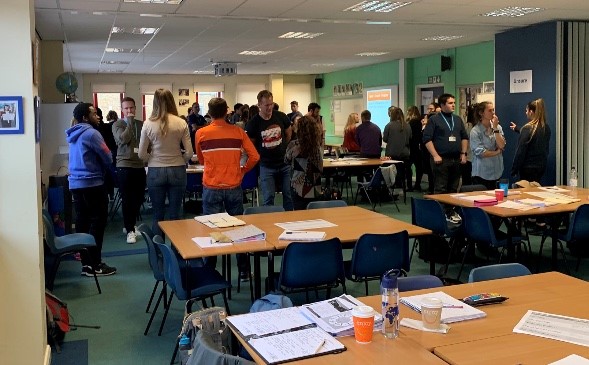Written by Robert Campbell
St Mary’s University joined the LASAR consortium a year ago. My engagement in the LASAR project has encouraged me to develop collaborative teaching between subjects on the PGCE programme.
Collaborative teaching provides a platform to celebrate how teachers develop knowledge in each subject. Through a greater appreciation of how subjects construct knowledge, trainees begin to uncover the role each subject plays in a holistic curriculum.
The epistemic insight initiative provides a series of workshops framed around big questions to uncover the types of knowledge that are required to provide a holistic answer. Secondary science PGCE students were introduced to two collaborative workshops framed around resources provided by the epistemic insight initiative.
In advance of the workshops, RE and science trainee teachers completed a collaborative lecture which encouraged trainees to discuss whether science and religion are necessarily in conflict.
During this session, I placed a Likert scale from strongly disagree to strongly agree across the room.
The photographs below show how the trainees would physically move to the statement that marked how they felt about the statement.

The ratio of science to RE trainees was 3:1, groups thus discussed any deviation from this ratio. Students had the opportunity to explain their views on what experiences informed their beliefs.
The statements were:
There is such a thing as absolute truth.
Teaching different subjects requires students to think differently.
Quantitative data is always more valuable than qualitative.
Development of science is about disproof, not proof.
Literal interpretation is the only way to read religious texts.
Trust in scientific data is a kind of faith.
Further conversations focussed on areas of the discreet subject curriculum where there is an overlap between RE and science namely
- The origins of life (RE GCSE curriculum)
- The origins of the universe (RE GCSE curriculum)
- The impact of science on Christianity, and Christianity’s response (RE A-level curriculum)
By contrast, the science curriculum has a more subtle link to separate disciplines. Part of the working scientifically skills at KS4 suggest students should “highlight the limitations of science”. Although this is not a direct link to RE, topics such as ethics consider disciplines outside science.
The session concluded by highlighting the potential impact of a compartmentalised curriculum and posed the question “How should science teachers’ answer questions about life after death?”
The first collaboration with secondary RE PGCE students focussed on the big question “Should science be used to create Saviour Siblings?“ This workshop introduced students to the stories of two families. The first was a family whose eldest child suffered from a rare form of Anaemia. The family chose to have a second child to help cure the illness of the first. This second child was selected from a range of embryos as he would be a good match for his elder brother. However, they had to travel to the USA to have treatment to conceive a second child through embryo selection as this was not legal in the UK at the time.
Subsequent changes in the law mean genetic preselection of embryos for the sole benefit of an elder sibling is now legal in the UK. This change in the law has not been accompanied by scientific progress in genetics. The trainees were then introduced to the stories of a second family who have been directly affected by this change in the law.
The trainees considered how these stories and lack of scientific progress informed their answers to the big question should saviour siblings be legal?
Perhaps unsurprisingly, the trainees had to reflect upon a range of different disciplines to answer the question. The required multidisciplinary approach outlines the limitations of a scientistic approach when considering big questions.
Trainees outlined the questions they would now ask because of engaging in the workshop and grouped these using the bubble tool (figure 1). The bubble tool provides a platform to group their questions as those which are amenable to science through to big questions.

FIGURE 1. The bubble tool which groups questions according to their amenability to science.
Below outlines, the type of questions students would ask which were amenable to individual subjects and the big questions students would aim to explore in their teaching.
Questions amenable to science:
-How do scientists know the embryo is likely to be a good match?
-How does IVF work?
Questions amenable to RE
– how does RE describe the
purpose of a family?
– how does RE explain the value of life and
quality of life?
Big questions
Do we need to believe in
something to do the righteous thing?
Is it just all chaos and randomness?
How do we find the ‘optimum’ family makeup?
The big question: Why did the Titanic sink?
A second workshop focussed on the connection between science and history by considering the big question “Why did the Titanic sink?”. Previous research from the LASAR consortium highlights the key vocabulary enquiry, evidence and knowledge are found in both the history and science curricula (Billingsley and Ramos Arias (2017). This workshop thus focussed on how these distinct disciplines used enquiry alongside the type of evidence distinct disciplines utilise to explain why the titanic sank. The workshop uncovered the kind of questions that were amenable to each specific discipline and the resultant pedagogical approaches taken by each discipline.
Questions amenable to science.
How did the changing temperature of the water affect the strength of the boat’s hull?
What force of impact is required to pierce the boat’s hull?
These questions lend themselves to conduct experiments which can gather data which measures how sudden temperature changes affect the tensile strength of metals.
By comparison, questions that are amenable to history; such as “What happened before the titanic sank?” encouraged trainees to use secondary sources such as diary entries or timelines as points of evidence.
Following on from identifying subject-specific questions, trainees worked collaboratively to plan a lesson on why the titanic sank. They were offered a range of resources from both historical and scientific perspectives and asked to justify which resources they would use. To my surprise, trainees could rationalise how they would use experimental and secondary evidence in their plans irrespective of their subject discipline.
As I plan for our PGCE course for the coming academic year, I will offer an additional collaborative session with RE. In these sessions, I will introduce my trainees to the epistemic insight framework for KS3. This resource (available here), provides a range of pedagogical approaches to support students move beyond a scientistic approach and recognise the role a multitude of disciplines play in answering big questions. Research in the coming year will identify whether our trainees incorporate lessons from their exposure to the EI workshops in their teaching an how the collaborative sessions inform trainee teachers views of science.
A more detailed summary of the collaborative sessions can be found in the September 2020 issue of school science review (Billingsley, B, Campbell. R, Dell, M. (2020) Epistemic insight, providing collaborative teaching between RE and science teachers. School science review, 102(378) pp. 54-58.
References
Billingsley, B. and Ramos Arias, A. (2017) Epistemic insight and classrooms with permeable walls. School science review, 99(367), pp.44-53
Robert Campbell is a Lecturer in primary and secondary science at St. Mary’s University Twickenham

